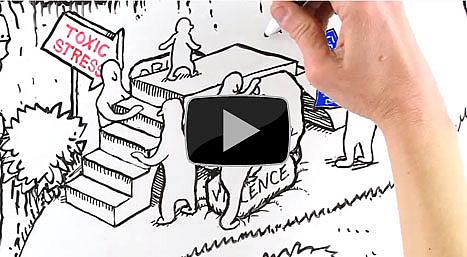Video Engages Viewers In New Child Development Theory

Image courtesy of Harvard University’s Center on the Developing Child
Tell someone you’d like to share your general theory of change for improving child outcomes and their mind is liable to wander off in the direction of dinner plans and the Netflix queue.
But couch that theory in an engaging animated YouTube video and suddenly you have an audience glued to the screen. Or at least that’s what Harvard University’s Center on the Developing Child is hoping for with the recently released video the center put together under the ponderous title “Building Adult Capabilities to Improve Child Outcomes: A Theory of Change.”
The five-minute film, made using an animated hand-drawn technique called scribing, weaves together decades of research that’s shown a child’s early environment and relationships have a huge and lasting effect on later learning, health and success. But when risk factors such as violence, abuse and neglect pile up, they can dramatically undermine a child’s prospects for a healthy, happy life. This gives rise to the center’s “theory of change,” which argues that policymakers and communities need to take a more hands-on approach in building the skills of the younger adults caring for these at-risk kids.
“We need to focus on their skills, their needs, in order for them to be better, more effective parents, in order for them to be better prepared to be employable, which would enhance the economic stability of the family,” says the film’s narrator, Jack Shonkoff, professor of child health and development at Harvard and the center’s director.
The center debuted the film in April at the Frontiers of Innovation conference.
“We’re very happy with the results,” said Al Race, the center’s deputy director. “We got very immediate feedback there that people really found it compelling.” The video reached the 10,000 hits mark faster than any of the center’s other videos. (A quick word of warning for those looking to tackle a similar style video: “It’s not cheap.”)
To produce the film, the center teamed with media production company Vital Pictures, who helped shape the film’s tone – they pushed to lighten it – and the images that bring potentially dry ideas to cinematic life.
“This was articulating a theory of change concisely and in a way that was memorable,” Race said. “We didn’t want it to look like a science textbook … It’s based on science, but it’s extrapolating from that to what we think needs to be done.”
Those looking for a binder of studies evaluating the center’s adult-skills theory will have to wait a little longer.
“The reason that it’s a theory of change rather than a strictly science video, is that to our knowledge no one has yet done what we’re suggesting needs to be done and evaluated it over long periods of time,” said Race, adding, “There’s no hard evidence that this kind of approach is going to be effective as an evidence-based approach.”
The science that does exist, however, tends to emphasize the importance of early parenting and a stable home environment. New York Times’ columnist Nicholas Kristof highlighted one such early study in his aptly titled “Cuddle Your Kid!” op-ed column last year:
One University of Minnesota study that began in the 1970s followed 267 children of first-time low-income mothers for nearly four decades. It found that whether a child received supportive parenting in the first few years of life was at least as good a predictor as I.Q. of whether he or she would graduate from high school.
Pointing to the generational transmission of poverty that can arise when children grow up in poor homes burdened with toxic levels of stress, Kristof holds out fresh hope:
Yet the cycle can be broken, and the implication is that the most cost-effective way to address poverty isn’t necessarily housing vouchers or welfare initiatives or prison-building. Rather, it may be early childhood education and parenting programs.
That focus on early childhood education even made it’s way into Obama’s budget earlier this year, when the president called for a $77 billion investment in universal Preschool for All as well as Early Head Start and home-visiting programs.
But the other half of that equation – the parenting programs – may be just as crucial in bettering the lives of both children and parents, as the Harvard center stresses in the theory-of-change video.
“The idea of two-generation programs is not new,” Race said. “What’s new is what we are coming to learn about the skills and capabilities adults need to not only raise successful children but to be successful economically.
Those skills and capacities include behaviors such as self-regulation, planning, problem solving, delaying gratification, and executive function. While we start acquiring these skills in infancy, there’s evidence that we can still learn these skills well into the third decade of life. And that suggests that with the right kind of help, parents and caregivers can make up some of the skill deficits that often come with growing up in a poor, stress-filled home.
That won’t happen with a few brochures or fleeting advice from the doctor’s office, however, and this is precisely where Dr. Shonkoff is pushing for a stepped-up investment in hands-on skill building: coaching, training and practicing basic skills with parents and care-givers. “But we’re not doing that,” he says in the video. (Happily, there appear to be exceptions.)
While the Center on the Developing Child’s primary audience is typically state-level policy makers and policy advisors, Race says the center hopes videos like these will also reach community members, practitioners and innovation-hungry leaders.
“We see this idea as something that is going to be of interest to … the people who are able to be change agents, the people who realize that the status quo is not good enough.”
Articulating a new vision is always the first step, and nothing bounds over communication barriers and leavens an otherwise serious conversation like a little animated short.

